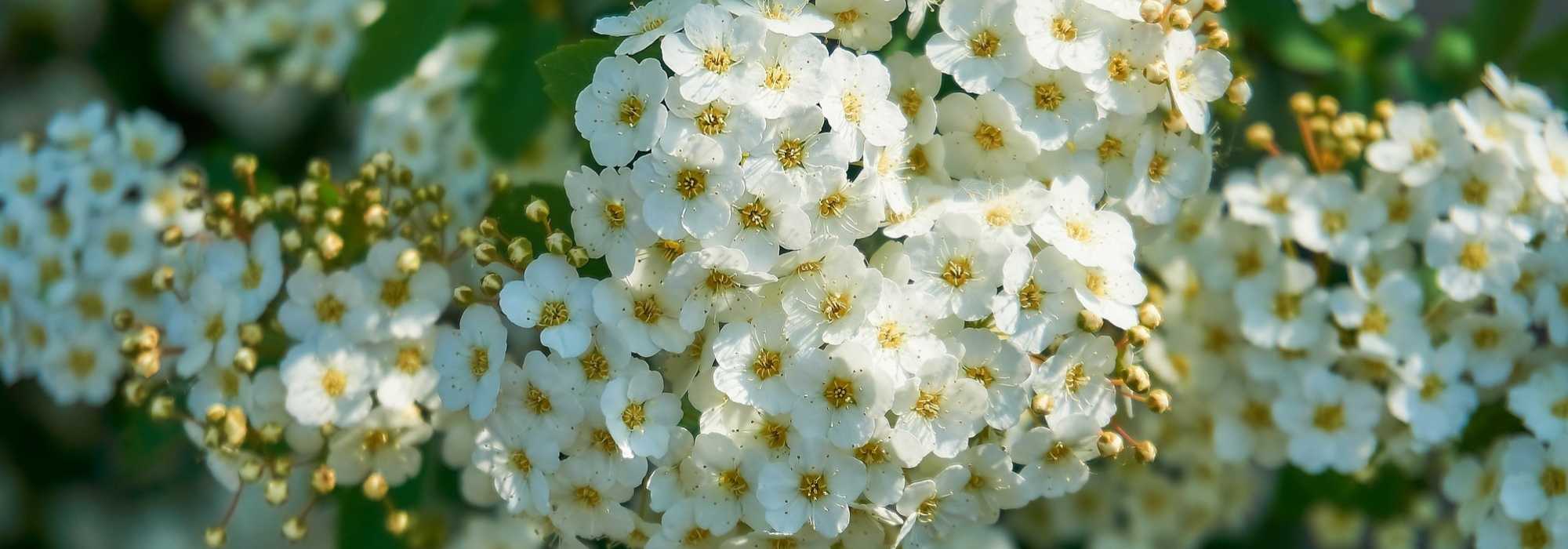
Pruning spring-flowering bushes
When and how?
Contents
Pruning of ornamental bushes is not strictly essential for their development but it helps ensure a fuller, more vigorous habit, rejuvenates them by guaranteeing a good level of flowering and, finally, gives them a pleasant, attractive shape that suits gardeners’ tastes.
This is known as “flowering pruning” to distinguish it from “formative pruning” carried out in the nursery. Timing of flowering means buds are produced at a specific time. Spring-flowering bushes enter a period of dormancy over winter so it is during the preceding summer that the buds containing the flowers form, sometimes even preceded by a miniature leafy shoot. It is important to prune taking this into account so as not to lose the flowering because of a timing error! That is why pruning at the right time is important.
Which ornamental bushes have spring flowering?
The bushes concerned by this pruning are ornamental deciduous or evergreen bushes whose fruiting is of no particular interest and flowering from January–March until 10–15 June. Bushes with decorative fruit are dealt with in the final section.
Deciduous bushes |
Evergreen bushes |
| Forsythia,
Japanese quince, Flowering currant (Ribes sanguineum, odoratum), Spring spirea (arguta, thunbergii, van Houttei), Mock orange (Philadelphus), Lilac, Deutzia, Barberry (ottawensis, thunbergii), Kolkwitzia, Amelanchier, Laurustinus (Viburnum tinus), Kerria… |
Barberry darwinii,
Cistus (rockrose), Osmanthus delavayi, Rosemary, Leptospermum, Bay laurel, Mexican orange… |
Exceptions to this specific pruning:
- heather soil bushes such as Azalea, Rhododendron, Camellia, Pieris, Andromeda, Hamamelis, Daphne, Kalmia, the heathers as well as Holly and Mahonia, which do not like much pruning. Removal of a few obstructive, broken or overly old branches is always possible, as is occasional cutting back of the whole bush. Nursery training of these bushes also involves pruning at planting to thicken the clump!
- evergreen hedging bushes for which spring flowering is not necessarily expected, such as Photinia, cherry laurel, Portuguese laurel, etc. These bushes can then undergo two to three prunings per year if judged too vigorous.
Read also
Pruning of summer-flowering bushesWhen is pruning of spring-flowering bushes?
These bushes carry their flower buds throughout winter before they open. Winter pruning would cancel a large part of the flowering.
However if you wait too long after flowering has finished (by mid-June at the latest for forsythia, July for mock orange), the bush will not have time to produce long shoots bearing buds before growth stops.
As a general rule, it is advisable to prune spring-flowering bushes flowering between January and 10 June, within 1 to 2 months after end of flowering
Note, however, that some bushes such as Hypericum species have a very spreading, perpetual flowering from May to October, so it is possible to prune them lightly in winter to reshape them without affecting the main part of the flowering.
Please note, regarding hedges, Regulation (EU) No 1306/2013 of the European Parliament and of the Council of 17 December 2013 requires Member States to take a measure on “the prohibition of cutting hedges and trees during the period of breeding and nesting of birds”. We recommend stopping trimming your hedges between 15 March and 31 July. In view of the collapse of biodiversity we are witnessing today, it is important that everyone acts in favour of conservation, notably of insects and birds:
- if you see nests in a hedge, avoid working at that spot;
- prune by hand instead so as not to disturb nesting and without excessively disfiguring the hedge;
- retain, as much as possible, areas of untrimmed and, if possible, diverse hedges, which does not necessarily imply a total absence of pruning;
- install nest boxes on east-facing wall of house or in trees because presence of hollow trunks is sorely lacking for many birds;
- and let a tall herb grow at base of hedges in order to allow, among other benefits, ground-dwelling birds to hide;
Reminder that use of pesticidal products by amateurs has been prohibited since 1 January 2019 and that spraying natural insecticidal products such as nettle manure must be done early morning or in evening when insects have stopped foraging.
Discover other Spring-flowering shrubs
View all →Available in 0 sizes
Available in 1 sizes
Available in 1 sizes
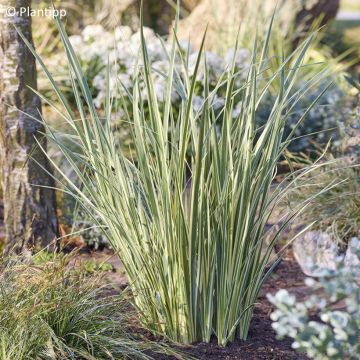
Available in 1 sizes
Available in 1 sizes
Available in 1 sizes
Available in 1 sizes
Available in 2 sizes
Available in 1 sizes
Available in 1 sizes
Pruning calendar for major spring-flowering bushes
Pruning months shown in table below correspond to Ile-de-France and Centre regions. Flowering times are one month earlier in Mediterranean region and two weeks later in mountain areas. Not all bushes listed need this flowering pruning (for example Amelanchier, Heather or Witch-hazel), but period for occasional pruning to regenerate a bush is still indicated.
Names in bold are hedging plants pruned several times a year and whose flowering is not necessarily preserved.
Don’t forget that each plant page you consult on our site gives detailed guidance on pruning!
| PRUNING MONTHS | SPRING BUSHES AFFECTED |
| January | Hazel, Elaeagnus x ebbingei, Russian olive |
| February | Smoke bush, Calluna (last month), Ornamental apple (last month), Shrubby potentilla, Rosemary |
| March | Bladder-senna, Berberis ottawensis, thunbergii, Callicarpa, Chimonanthus praecox, Rockrose, Cornus (alba, stolonifera, sanguineum), Cotoneaster, European spindle, Spanish broom, Hippophae rhamnoides, Hypericum (calycinum, ‘Hidcote’), Holly, Bay laurel, Willows vitellina, viticella, purpurea (short pruning), Viburnum (bodnantense, fragrans, rhytidophyllum) |
| April | Box, Cornus mas, Daphne mezereum, Lonicera nitida, Mimosa |
| May | Japanese quince, Laburnum; Erica, Escallonia, Forsythia, Flowering currant, Lilac, Lonicera tatarica, Mahonia aquifolium, Cherry laurel, Laurustinus, Prunus triloba, Spiraeas (arguta, thunbergii), Spring tamarisk |
| June | Berberis (buxifolia, candidula, verruculosa), Elaeagnus x ebbingei, Photinia |
| July | Calycanthus, Ceanothus (arboreus, impressus, prostratus, thyrsiflorus), Cornus (florida, kousa), Deutzia, Russian olive, Mock orange, Spiraea (nipponica, vanhouttei), Viburnum (opulus, plicatum), Weigela |
| August | Box, Escallonia, Photinia |
| September | Cherry laurel, Elaeagnus x ebbingei |
Read also
Pruning spring-flowering bushesHow to prune spring-flowering bushes?
Pruning consists of removing old shoots to allow emergence of vigorous, floriferous shoots at base of bush. This pruning is completely different from tree pruning, where architecture of trunk and main branches selected during formative pruning is preserved.
Three cases can be distinguished :
- pruning of deciduous bushes with spring flowering,
- pruning of evergreen bushes with spring flowering,
- pruning of bushes with spring flowering and decorative fruits.
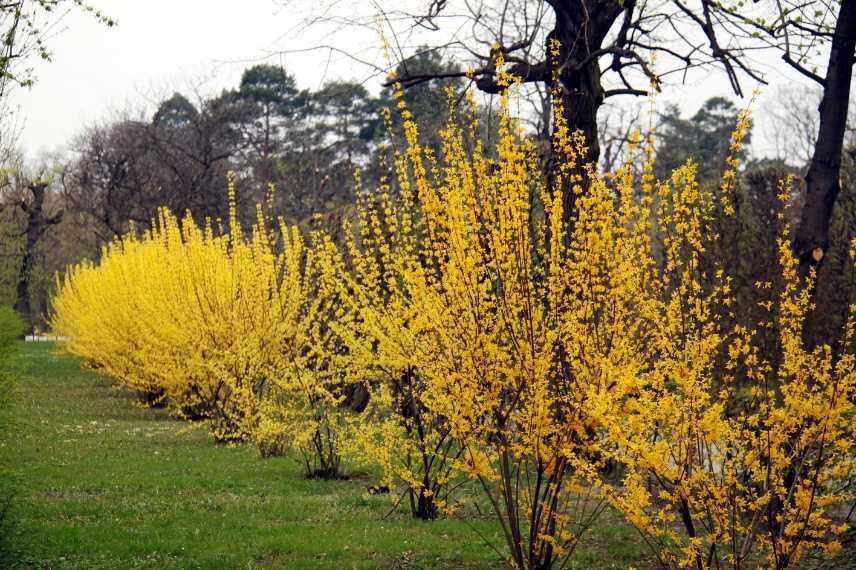
Forsythias (photo Eva Deuffic)
Case 1: deciduous bushes with spring flowering (Forsythias, Cotinus, Berberis, Potentillas, Cytisus…)
Pruning of this category of bushes consists of:
- Removing entirely shoots that are too thin, damaged, twisted or crossing, to encourage light penetration to centre of stump.
- Cutting back to their base very long shoots that have flowered,
- Shortening by one third shoots that have flowered and are moderately long.

Left: Flowered shoot after pruning – Right: 2-year-old flowering shoot, flowers move away from main axis (photo Eva Deuffic)
Japanese kerria (Kerria japonica), a special case: in June, cut entirely all shoots that have flowered as they tend to dry out during summer. This pruning can also be carried out in winter.
Case 2: evergreen bushes with spring flowering
Evergreen bushes are pruned lightly just after flowering (Berberis darwinii, Osmanthus delavayi, rosemary, Leptospermum, bay laurel). With Mexican orange, removal of fruits leads to a return of flowering in autumn.
Case 3: bushes with decorative fruits
Their flowering may occur:
- in spring on wood of previous year: Hippophae rhamnoides (sea buckthorn), Rugosa rose, elder, Viburnum, Elaeagnus multiflora,
- or in late spring–summer on shoots of the year: bladder senna, Callicarpa…
In both cases, carry out a light pruning in late winter (March) simply to balance the bush.
Which tools to use? Hedge trimmer, shears, pruning shears?
Bushes left in free habit are pruned with a small pruning shear, or even with a heavy‑duty pruning shear with curved blades or with a pruning saw for large branches.
Hedges are trimmed with shear or with hedge trimmer, petrol or electric, bearing in mind that a touch‑up with pruning shear of stubs formed by repeated cuts in the same place should be carried out about every 3 years.
Carry out pruning with well‑sharpened tools disinfected with alcohol to promote good wound healing and avoid transmitting disease. Make angled cuts about 0.5 to 1 cm above a leaf or a bud. When removing old wood, it does not matter where the cut is made: plant will respond either by stimulating emergence of deep buds that will pierce bark to produce new shoots, or by producing suckers directly from soil.
- Subscribe!
- Contents































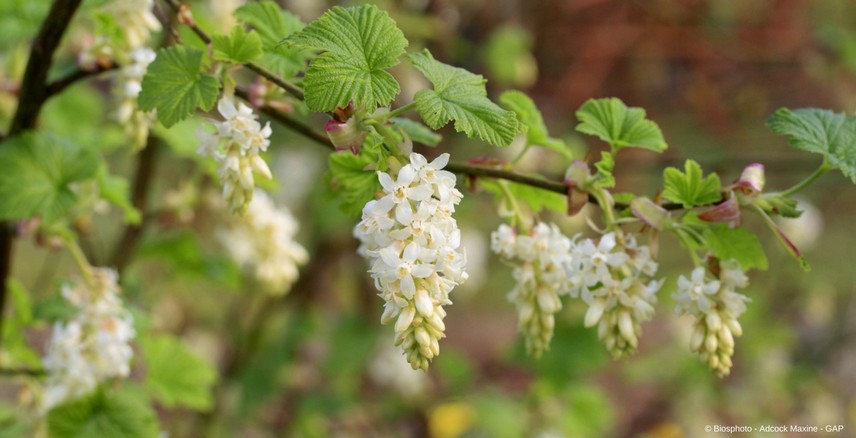

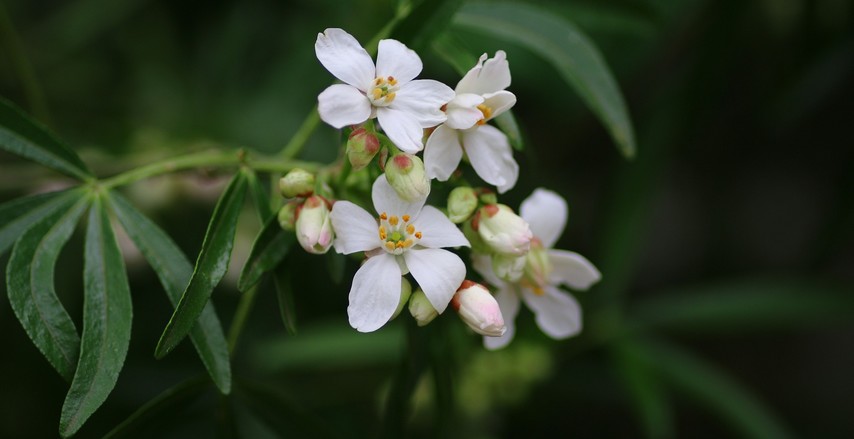



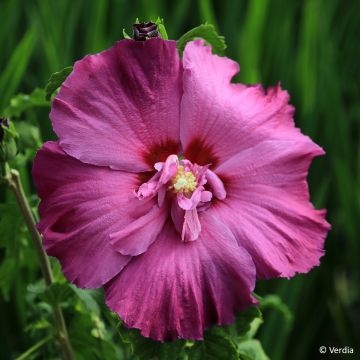
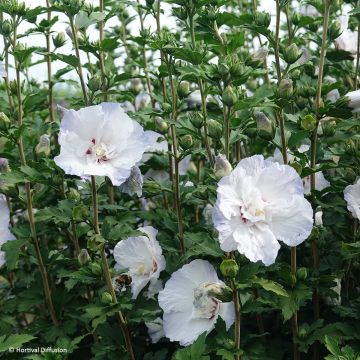


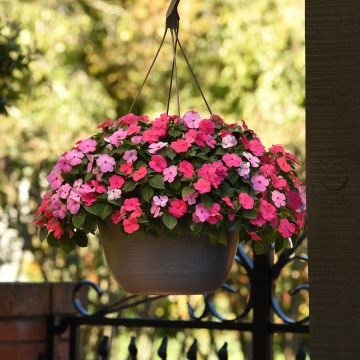
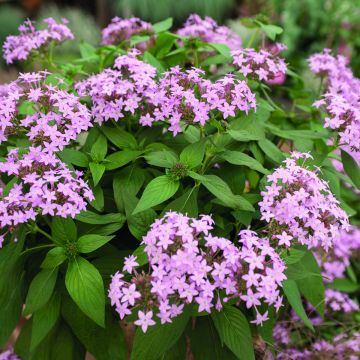
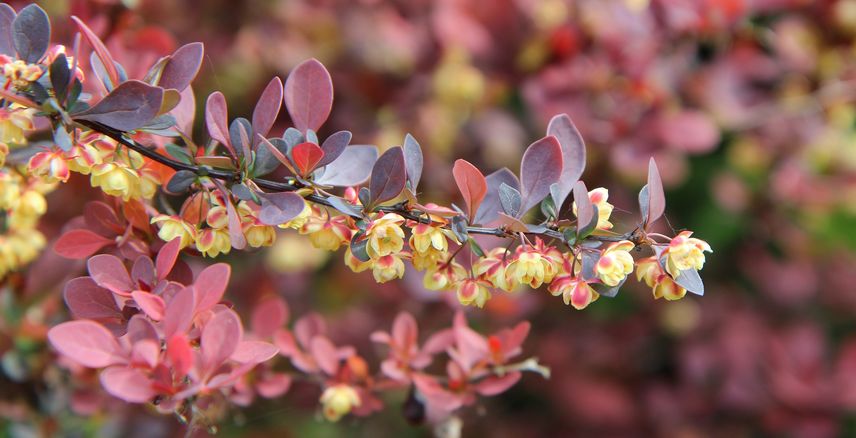
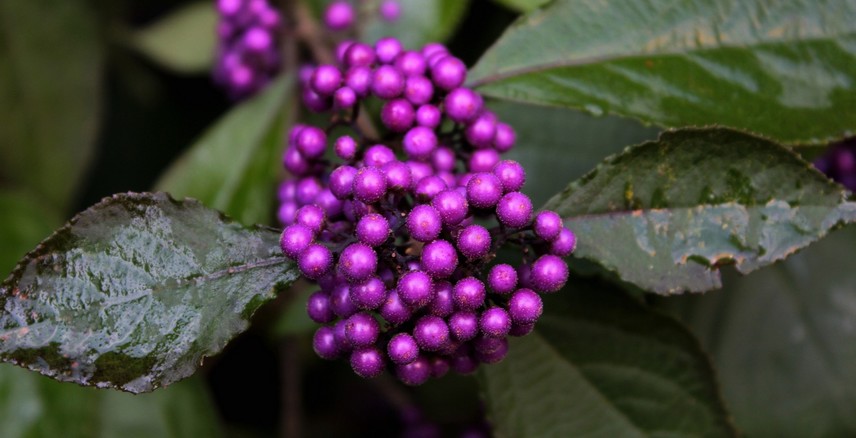
Comments